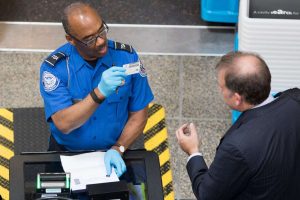APRIL 28, 2019

Take a look at your driver’s license.
Go ahead, we’ll wait while you fish it out of your wallet.
If your driver’s license doesn’t have a star in the upper corner of the card, then your license is not Real ID compliant. And if you’re planning to take a domestic commercial flight any time after Oct 1, 2020, you’ll need to take action, make some decisions or wait for your state to get its act together.
What’s Real ID?
The Real ID Act is legislation passed in 2005 (in response to the 9/11 terrorist attacks) that set new and higher minimum security standards for the driver’s licenses and identification cards that will be accepted at airports, other federally regulated facilities and nuclear power plants.
Debates and pushback from some states over the impact of Real ID have created confusion and delayed the official rollout of the act’s enforcement, but Oct. 1, 2020, is now considered the firm date for enforcement at commercial airports.
“The main pushback on REAL ID is that it’s too Big Brother,” said Jeff Price, an aviation security expert with Leading Edge Strategies. “It’s a move to make everyone in the U.S. have identification, which tends to upset those who enjoy life off the grid or don’t like any more government intrusion into their lives than what is necessary.”
But, Price notes, nearly every state has come into compliance. “And there hasn’t been the Big Brother/illegal shakedown issues that some people predicted,” he said.
How do you get a Real ID-compliant license, and when can you get it?
Here’s where things can get tricky.
The Department of Homeland Security has been phasing in enforcement of the Real ID Act in an effort to give states time to become compliant with the rules and to begin issuing enhanced driver’s licenses and ID cards in time for the Oct. 1, 2020, deadline.
Most states are currently in compliance with the Real ID Act and are able to issue upgraded licenses and IDs. The DHS website has a map you can check to find out the status of your state.
Seven states (Oregon, Oklahoma, Kentucky, Pennsylvania, New Jersey, Rhode Island and Maine), plus American Samoa, have been granted extensions with varying deadlines for meeting the rules. (Some have until Aug. 1, 2019, while others have until Oct. 10, 2019).
California’s status regarding Real ID compliance is listed as “under review” with a much shorter deadline of May 24, 2019, for achieving compliance.
What this means:
If your current driver’s license or ID card is from a compliant state, the Transportation Security Administration will accept it at airports until Sept. 30, 2020. Starting Oct. 1, 2020, though, licenses and IDs from these states will need to bear a star or special symbol that shows it has been upgraded to conform to the new minimum security standards.
If your current license is from one of the seven states that has been given an extension, or from California, then it is good until the date the extension expires. After that, if the state isn’t given another extension, is it possible the TSA will require an additional or alternate form of ID (i.e., a passport) between the extension expiration date and Sept. 30, 2020.
Come Oct. 1, 2020, though, licenses from these extension states will also need to have the star or symbol that shows it has been upgraded to meet the new minimum security standards.
Getting ready for Oct. 1, 2020
Signs about the Real ID deadline are going up now in airports across the country.
Oct. 1, 2020, seems far off, but it is “just” a year and a half away. And there’s sure to be continued confusion and delays in getting upgraded licenses and ID cards from state agencies.
For that reason, the TSA, the DHS, airports and travel agents are urging travelers to renew their driver’s licenses or state IDs early and to be sure to opt for the “enhanced” or “compliant” versions which, we should warn you, require additional paperwork and may cost more than the “for driving only” or “unenhanced” versions in some states.
Or, you can decide if you are comfortable flying domestically with your passport (if you have one; only about 40% of Americans do) or with one of the other forms of approved identification on the TSA’s list.
Courtesy/Source: USA Today











































































































